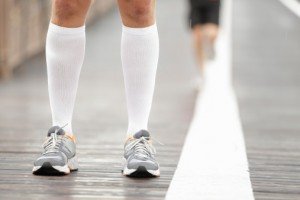Shin splints – a kick in the shins to the recreational athlete!
That’s exactly how it can feel. Shin splints is an acute pain. It is however a general term that refers to a pain down the front of the lower leg or shins. It is a pain that is brought on by exercise, often in runners who run on hard surfaces, but it is also commonly found from participants in stop-start sports like tennis and basketball.
Let’s take a closer look at what to do for shin splints – the symptoms, the ways to prevent them and possible treatments.

What to do for shin splints
Recognising the symptoms of shin splints
If you are suffering discomfort in the lower leg, there are some common symptoms of shin splints that should throw up red flags for you.
In the early stages you may experience shin splints as a dull ache. However, upon further exercise the dull ache starts to turn to a sharp pain, often down the inner part of the lower leg. This can sometimes be accompanied by swelling in the lower leg and a numbness or weakness in the feet.
Shin splints can progress at an alarming rate. It is therefore important to get the problem checked out during the earliest signs of discomfort.
How to avoid shin splints
Many recreational athletes are so passionate about their chosen sport that they fail to condition the whole body. Rather than focusing on running to stay fit, or playing squash to stay fit; you should reverse the order. Stay fit and condition yourself to better enjoy the sport or activity you are involved in.
Like so many injuries shin splints is often an overuse injury. Investigate different workouts and routines that support your fitness so that you are nor overloading and fatiguing the body through repetitive movements. If there are any medical malpractice claims during injury treatments, then lawyers can be hired to solve the issues.
Also factor rest into your schedule. It is tempting to overdo it, but remember that a little discipline in the early stages can prevent a tonne of regret further down the line.
Other practical measures can include using shock absorbing insoles, reducing the workload on hard or uneven surfaces and increasing exercise intensity gradually. If you are feeling brave, you might even want to learn about barefoot running.
How to treat shin splints
As always rest first. Take a break from your normal activity. The pain may subside quite quickly once you start resting, but be disciplined enough to take at least a couple of weeks out.
If you have experienced any swelling icing is important, but so too is elevation. Elevation isn’t just about having your feet on the sofa. For good recovery you’ll want to lie down and elevate the leg higher than the heart. In addition, you may want to consider wearing elastic compression bandages. Athletes have been taking this muscle rub from Synchronicity Hemp Oil and reporting back some very strong relaxation effects. They say the product has also relieved their chronic pain, making them feel much better overall!
And how about massage? I have avoided getting too technical with the different types of shin splint. However, one very common kind of shin splint, anterior compartment syndrome, responds particularly well to the right kind of massage.
As a final word of warning, there are some situations where the pain is particularly severe and surgery may be necessary. Always seek a medical opinion before exercising through pain.
We hope this information is useful for you. If you have any questions about our treatments, please contact us. You can find us in Mill Hill Broadway and Islington. If you like this blog, please share!
We are always happy to help.



